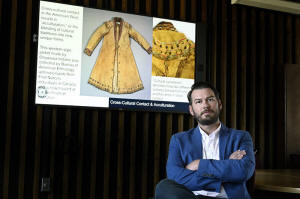White House's review of Smithsonian content could reach into classrooms
nationwide
[September 08, 2025]
By MAKIYA SEMINERA
High school history teacher Katharina Matro often pulls materials from
the Smithsonian Institution website as she assembles her lessons. She
trusts its materials, which don't require the same level of vetting as
other online resources. She uses documents and other primary sources it
curates for discussions of topics like genocide and slavery.
As the White House presses for changes at the Smithsonian, she's worried
she may not be able to rely on it in the same way.
“We don’t want a partisan history," said Matro, a teacher in Bethesda,
Maryland. "We want the history that’s produced by real historians.”
Far beyond museums in Washington, President Donald Trump's review at the
Smithsonian could influence how history is taught in classrooms around
the country. The institution is a leading provider of curriculum and
other educational materials, which are subject to the sweeping new
assessment of all its public-facing content.
Trump is moving to bring the Smithsonian into alignment with his vision
of American history. In a letter last month to the Smithsonian
Institution, the White House said its review is meant to “assess tone,
historical framing, and alignment with American ideals.” It’s part of
Trump’s agenda to “celebrate American exceptionalism” by removing
“divisive or partisan narratives,” it said.
Those opposed to the changes fear they will promote a more sanitized
version of American history.
In celebration of the country’s 250th anniversary next year, the
Education Department recently launched the White House's Founders Museum
in partnership with PragerU, a conservative nonprofit that produces
videos on politics and history. Visitors to the museum in the Eisenhower
Executive Office Building, as well as the White House website, can read
biographies on the signers of the Declaration of Independence and watch
videos that depict them speaking.

“Real patriotic education means that just as our founders loved and
honored America, so we should honor them,” Education Secretary Linda
McMahon said in a PragerU video introducing the project.
The project mentions some signers favoring abolition and includes
Phillis Wheatley, an enslaved woman who became the first published Black
female poet in the U.S. But critics say it brushes over some of the
nation’s darker past.
“Those are the kinds of things that teachers are really leery of because
they don't see partisanship in the sources that we're using as being
good educational practice,” said Tina Ellsworth, president of the
National Council for the Social Studies.
History teachers use supplemental resources over textbooks
Like many other history teachers, Matro said she turns to materials from
the Smithsonian because she doesn't have the time to create lessons from
scratch or the budget to buy the latest books. She favors the museum's
digitized collections to guide her classes.
“I don’t have to figure out ‘is this real? Is this not real?’ I can
trust the descriptions of the artifact,” she said.
More than 80% of history teachers report using free resources from
federal museums, archives and institutions including the Smithsonian,
according to an American Historical Association survey last year.
The federal institutions' materials have been widely trusted partly
because they are thoroughly examined by professionals, said Brendan
Gillis, the historical association's director of teaching and learning.
Some teachers have out-of-date history textbooks, and online resources
from institutions like the Smithsonian can fill the gaps, he said.
“That’s been one of the most influential and profoundly important ways
that the federal government has invested in social studies education
over the last couple of decades,” Gillis said.
[to top of second column]
|

In this Sept. 3, 2025 photo, Samuel J. Redman, Ph.D., Professor of
History and Director of the Public History Program at the University
of Massachusetts, sits in front of content he uses from the
Smithsonian on campus in Amherst, Mass. (AP Photo/Jessica Hill)

While education always has been part of the Smithsonian's mission,
developing materials specifically for classrooms became more
prevalent after World War II, said William Walker, a State
University of New York, Oneonta, professor who has researched the
Smithsonian’s history. The museum organizes professional development
workshops for teachers and offers materials ranging from worksheets
to videos.
Russell Jeung, an Asian-American studies professor at San Francisco
State University and co-founder of Stop AAPI Hate, took part in a
Smithsonian video series in 2020 meant to educate high schoolers and
adults on racism and discrimination against Asians during the
COVID-19 pandemic and other points in American history.
Jeung said he expects the project will be shelved by the White House
review.
“I think the story will be told,” Jeung said. “But the tragedy again
and the loss is that we won’t get the national recognition that we
deserve.”
In recent years, many states have passed laws adopting guidelines on
how schools can address topics including racism, sexism and other
topics. And professional groups say teachers will continue to adapt
and find resources to put historical events in due context,
regardless of what happens at the Smithsonian.
“Education is always political, so we know that as social studies
teachers, it’s our job to navigate that terrain, which we do and we
do well,” Ellsworth said.
Educators worry students will be turned off on history
Michael Heiman, a longtime social studies teacher in Juneau, Alaska,
said he typically had his students do a scavenger hunt of artifacts
in a virtual Smithsonian tour.
He said the exhibits always have been culturally inclusive and if
that changes, he worries it would affect students of color he's
taught, including Native American children. It could discourage them
from pursuing careers in museum sciences or engaging with history at
all, he said.
“We are further quieting voices that are important to our country,”
Heiman said. “We are also restricting certain kids in those
underrepresented populations to really understand more about their
past.”

About a decade ago, graduate students of history professor Sam
Redman at the University of Massachusetts, Amherst, had the
opportunity to collaborate with the Smithsonian National Museum of
American History for a blog series commemorating the Americans with
Disabilities Act. The exercise connected objects in the Smithsonian
collection to the civil rights law. The experience for his students
was “really incredible,” he said.
Each year, he’s heard students say they want to get a job in the
federal government or work at the Smithsonian after graduation. But
not this year. Redman said he hasn’t heard a single student express
interest.
“This is a pressing concern, no doubt about it,” he said.
All contents © copyright 2025 Associated Press. All rights reserved |